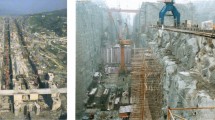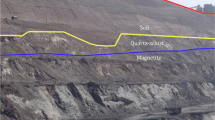Abstract
In this paper, a new kinematics and stability analysis method of rock blocks considering finite discontinuity persistence is poposed as a stability evaluation method in excavations. The 3D rock block identification considering finite discontinuity persistence is performed using discontinuity disk model. The kinematics and stability analyses of removable rock blocks formed by the identification method are performed. The new analysis method can handle convex and concave shaped blocks. The kinematics and stability analysis method of rock blocks considering finite discontinuity persistence consists of the following major steps: (1) Three-dimensional discontinuous rock mass modeling, (2) Identification of two-dimensional loops, (3) Identification of three-dimensio nal loops, (4) Finalization of block shape and volume, and (5) Kinematics and stability analysis of removable rock blocks. In order to illustrate the applicability of the new kinematics and stability analysis method of rock blocks considering finite discontinuit y persistence, two analysis example problems were carried out. This study presents the example problems for a convex shaped block and a concave shaped block. The comparisons and investigations with the analytical results have confirmed the effectiveness and usefulness of this new kinematics and stability analysis method of rock blocks proposed as a stability evaluation method in excavations.
Similar content being viewed by others
References
Dershowitz, W.S. (1984).Rock joint systems, Ph.D. Dissertation, Massachusetts Institute of Technology, Cambridge, USA.
Foley, J.D., Dam, A.V., Feiner, S.K., and Hughes, J.F. (1992).Computer graphics, 2nd Ed., Addison-Wesley Publish Company, New York.
Goodman, R.E. and Shi, G.H. (1985).Block theory and its application to rock engrg., Prentice-Hall.
Hwang, J.-Y., Ohnishi, Y., and Nishiyama, S. (2002). “Key block analysis in tunnel construction for the geological disposal of highlevel radioactive waste.”Proc. 2nd Japan-Korea Joint Seminar on Geoenv. Engrg., Japan, pp. 61–68.
Hwang, J.-Y. (2003).Stability evaluation of rock blocks in tunnels for observational method. Ph.D. Dissertation, Kyoto University, Kyoto, Japan, pp. 289.
Hwang, J.-Y. and Ohnishi, Y. (2003). “New mechanized tunneling method and its application to large tunnel.”Proc. 35th Sym. on Mechanized Tunneling Techniques, KTA, pp. 159–174.
Hwang, J.-Y. (2004). “New observational design and construction method in tunnels and its application to very large cross section tunnel.”Jour. of the KGS, KGS, (Accepted).
Hwang, J.-Y., Sato, M. and Ohnishi, Y. (2004). “Quick evaluation method for discontinuity properties by vision metrology for observational design and construction method in tunnels.”Proc. 33rd Rock Mech., JSCE, Japan, pp. 187–192.
Kulatilake, P.H.S., Wathugala, D.N.M., and Stephansson, O. (1993). “Joint network modeling with a validation exercise in Stripa mine, Sweden.”Int. Jour. Rock Mech. Min. Sci. & Geomech. Abstr., Vol 30, No. 5, pp. 503–526.
Long, J.C.S. and Billaux, D.M. (1987). “From field data to fracture network modeling; an example incorporating spatial structure.”Water Resources Research, Vol. 23, No. 7, pp. 1201–1216.
Mardia, K.V. (1972).Statistics of directional data, Academic Press Inc., London.
Ohnishi, Y., Nagano, K., and Fujikawa, T. (1985). “Evaluation of stability of excavated jointed rock mass by block theory.”Jour. Geotech. Engrg., JSCE, No. 364/III, pp. 209–218.
Ohnishi, Y., Nakagawa, S., and Tanaka, M. (1994). “Methods of estimation for geometric distributions of rock joints.”Jour. Geotech. Engrg., JSCE, No. 499/III-28, pp. 59–68.
Ohnishi, Y. (1999). “Survey, analysis and evaluation for discontinuous rock mass.”Soil and Foundation, JGS, vol. 47–12, pp. 61–62.
Ohnishi, Y. (2002). “Keynote lecture: Numerical methods and tunneling.”Proc. of the Fourth Int. Summer Symp., JSCE, Kyoto, Japan, pp. 1–21.
Pahl, P.J. (1981). “Estimating the mean length of discontinuity traces.”Int. Jour. Rock Mech. Min. Sci. & Geomech. Abstr., Vol. 18, pp. 221–228.
Pollard, D. and Aydin, A. (1988). “Progress in understanding jointing over the past century.”Geol. Soc. of America Bulletin, Vol. 100, pp. 1181–1204.
Priest, S.D. (1993).Discontinuity analysis for rock engrg., Chapman & Hall.
Warburton, P.M. (1980). “A stereological interpretation of joint trance data.”Int. Jour. Rock Mech. Min. Sci. & Geomech. Abstr., Vol. 17, pp. 181–190.
Yu, Q. (2000).Analyses for fluid flow and solute transport in discrete fracture network, Ph.D. Dissertation, Kyoto Univ, Kyoto, Japan.
Zhang, L. and Einstein, H.H. (2000). “Estimating the intensity of rock discontinuities.”Int. Jour. Rock Mech. Min. Sci., Vol. 37, Issue 5, pp. 819–837.
Author information
Authors and Affiliations
Corresponding author
Rights and permissions
About this article
Cite this article
Hwang, JY. Kinematics and stability analysis method of rock blocks considering finite discontinuity persistence. KSCE J Civ Eng 8, 397–402 (2004). https://doi.org/10.1007/BF02829163
Received:
Accepted:
Issue Date:
DOI: https://doi.org/10.1007/BF02829163




